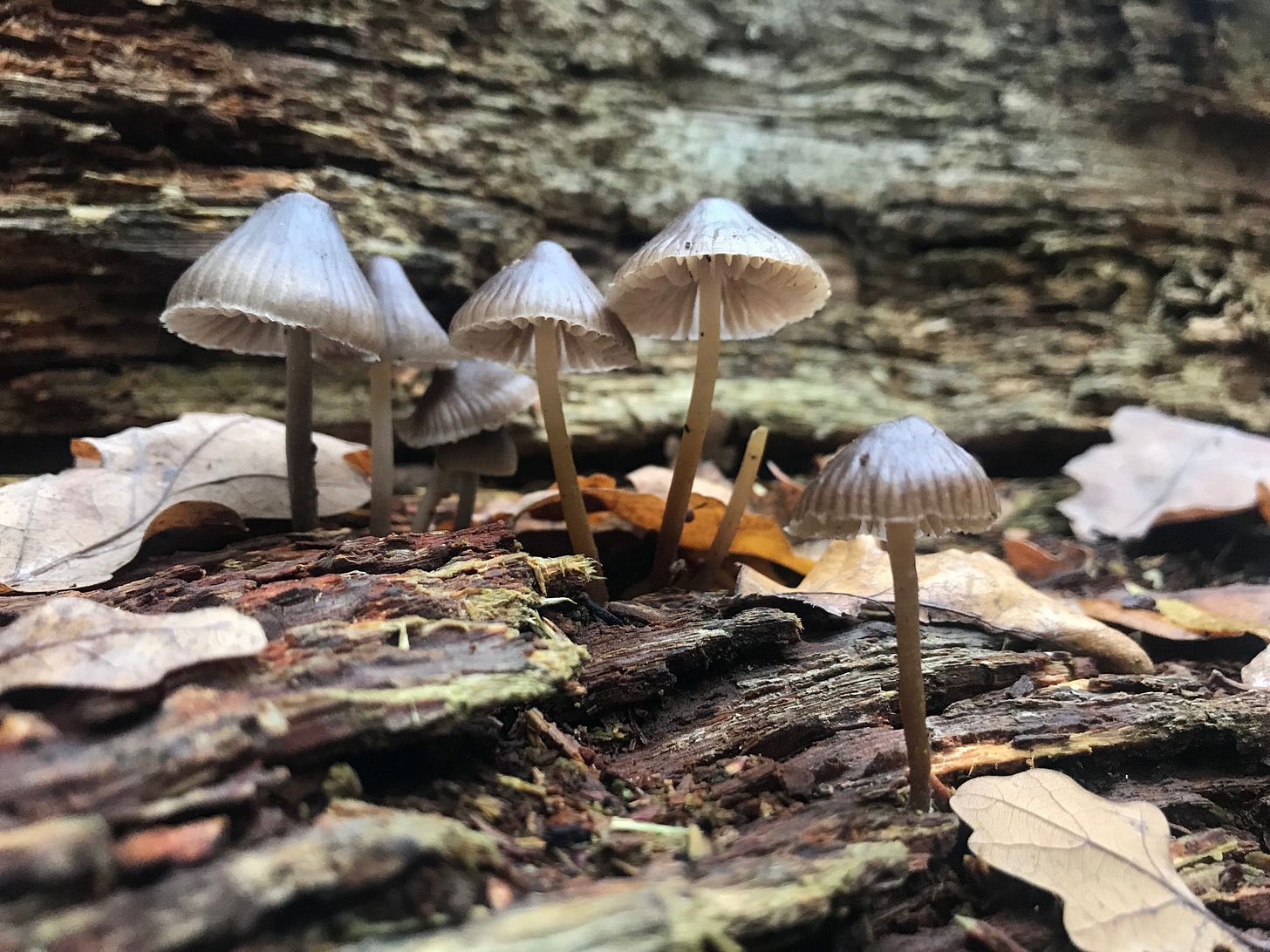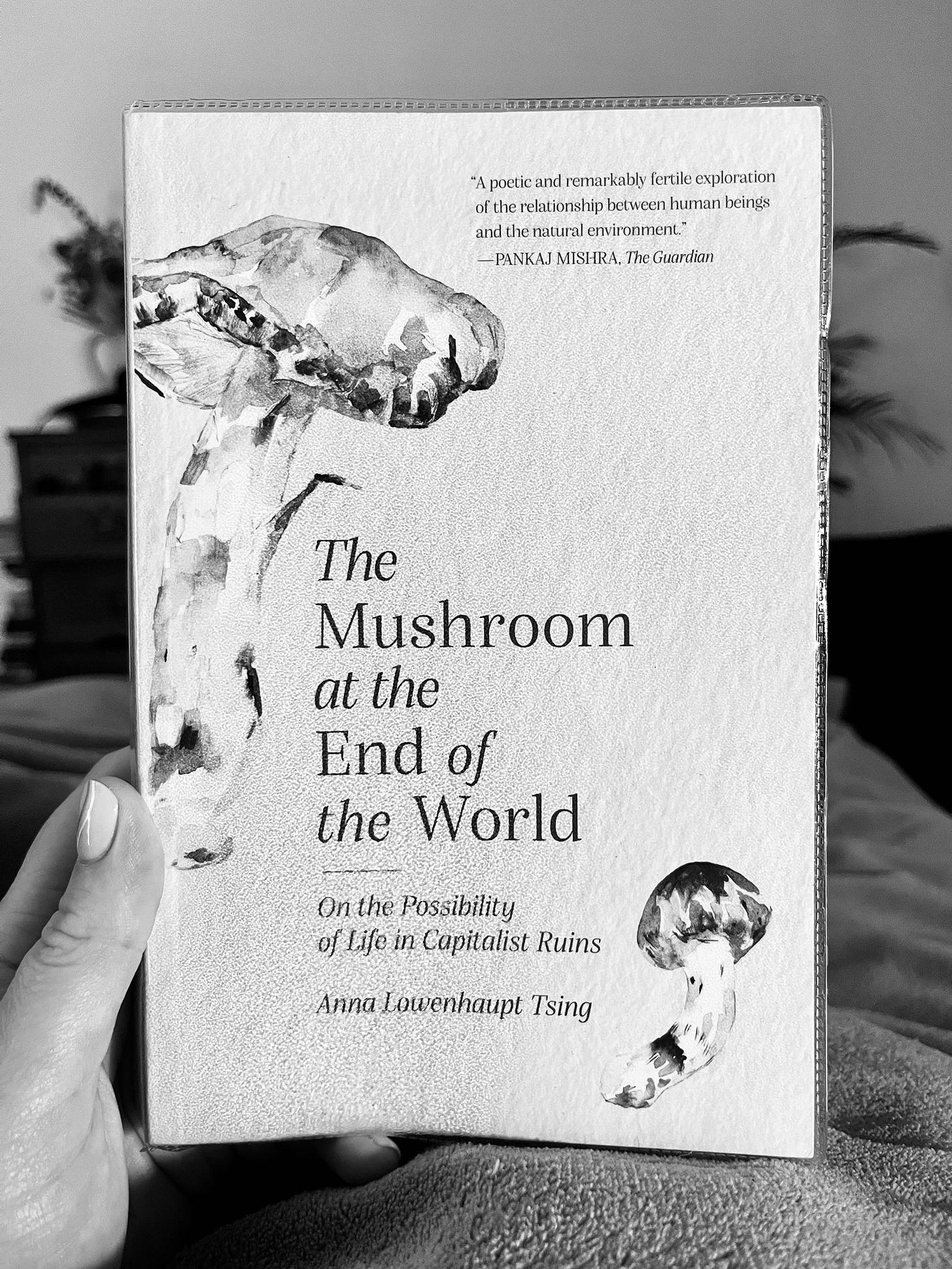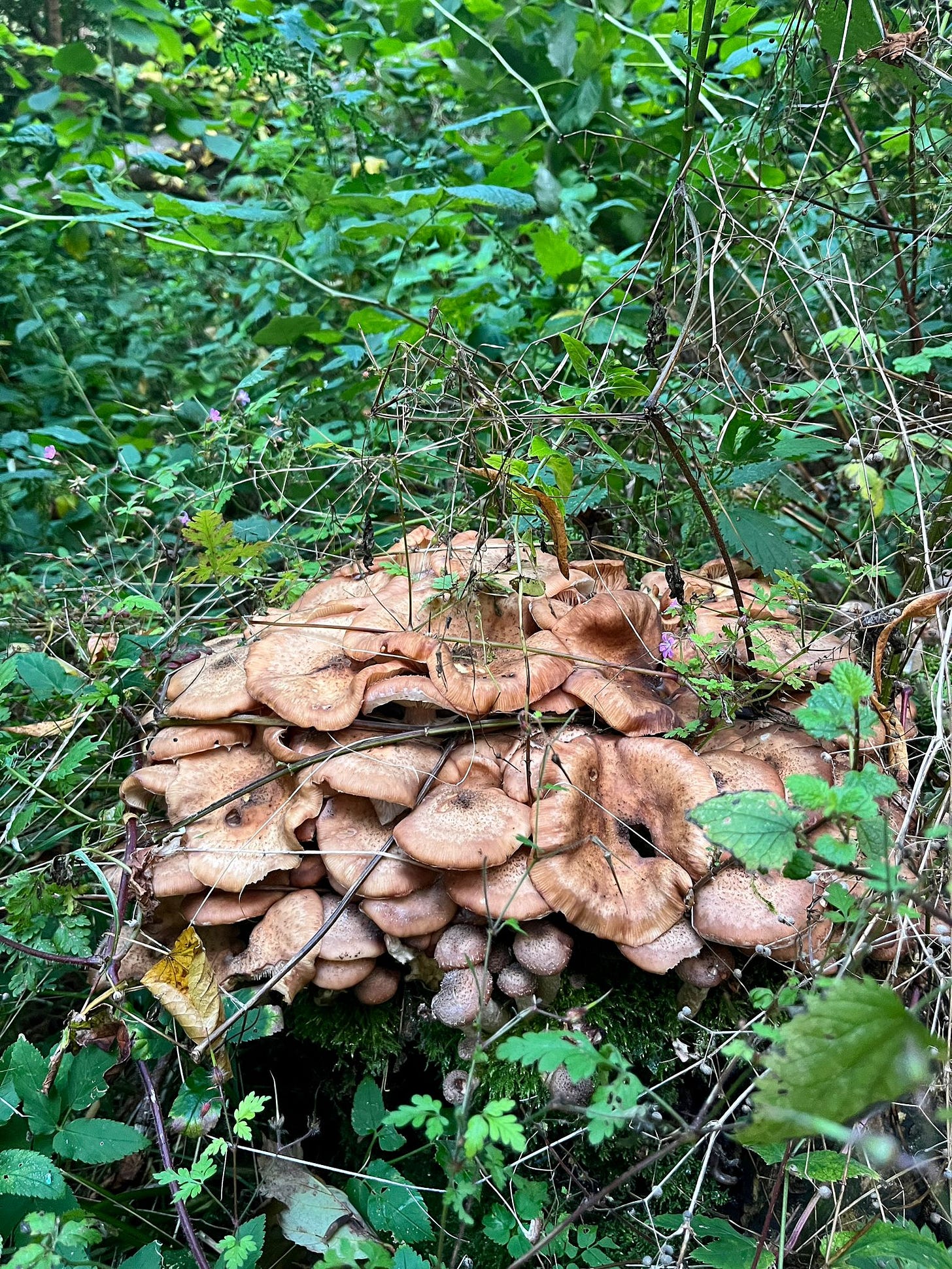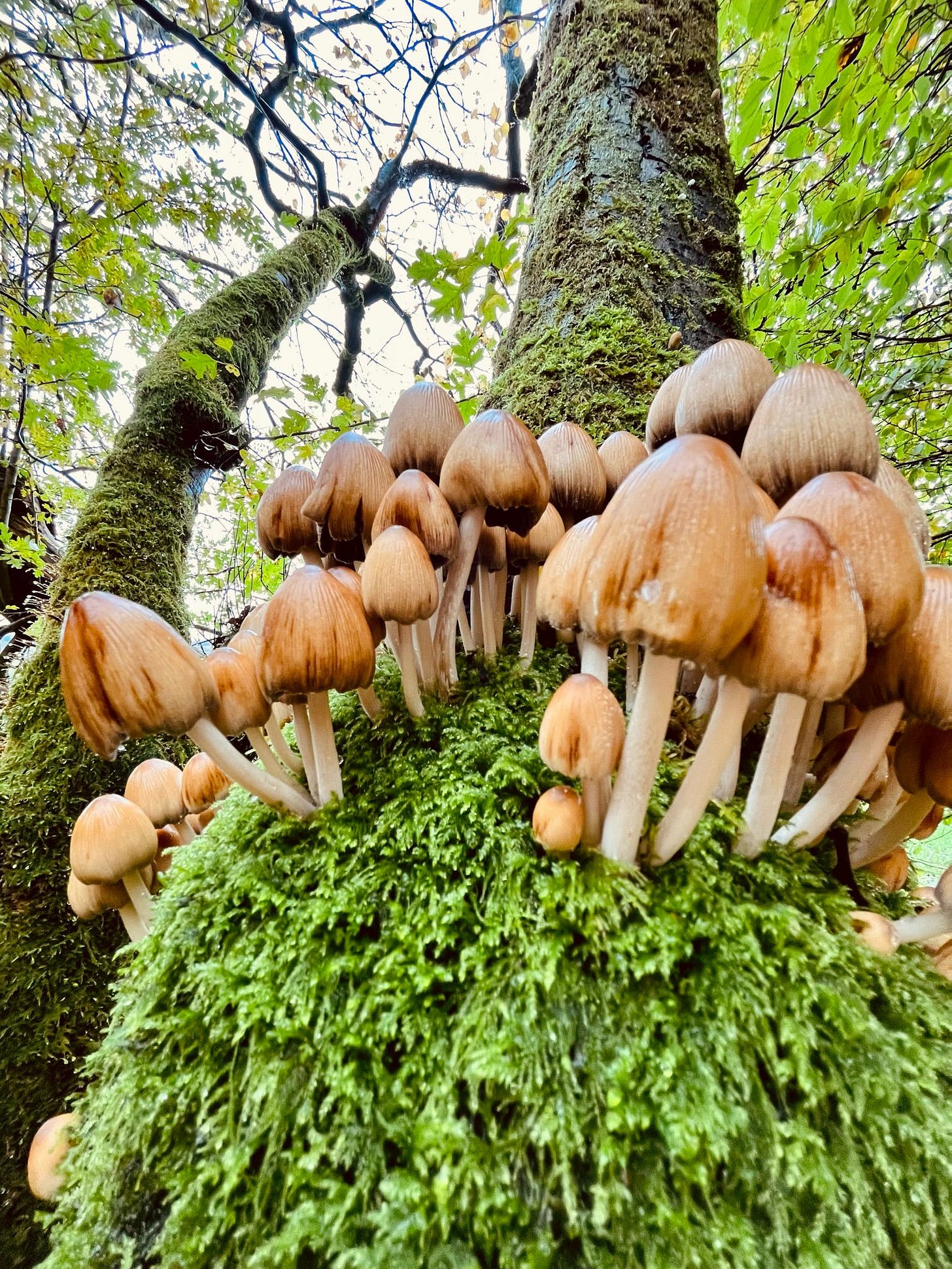[Book review] The Mushroom at the End of the World: On the Possibility of Life in Capitalist Ruins
~ Anna Lowenhaupt Tsing
In The Mushroom at the End of the World, Anna Tsing1 presents the Anthropocene as a 'patchy’, fragmented assemblage. This assemblage is not uniform or homogenous; instead, it is made up of diverse, interrelated ecosystems that exhibit varying degrees of health and resilience. She argues that learning to observe and describe this patchiness is essential for recognising the connections and processes needed to envision radical alternatives to capitalism2. Tsing introduces the concept of a nonbinary "third nature" (p. viii)—defined as that which persists despite capitalist environmental destruction—to examine how humans and more-than-human entities are alienated, commodified, and exchanged under capitalism. This third nature is symbolised by Japanese delicacy the matsutake mushroom, which thrives as a direct consequence of human disruption to forests. These mushrooms form a symbiotic relationship with the roots of trees like pines and firs, especially in ecosystems that have been stressed or disrupted by logging, thinning, or wildfires. These activities often promote the growth of younger, open-canopy forests, where ideal hosts for matsutake dominate. This disruption reduces competition and creates the well-drained, nutrient-poor soils that matsutake prefer, allowing them to thrive. Through a detailed practical, cultural, and historical exploration of global matsutake supply chains, Tsing demonstrates that "life requires the interplay of many kinds of beings" (p. vii) and that capitalism relies on relationality, reciprocity, and non-capitalist processes to generate value.
Tsing positions alienation as a key mechanism of capitalist simplification and control. Alienation severs the interdependence and relational value of humans and more-than-humans, commodifying them and reducing them to exchangeable assets—a process she describes as "barcoding life" (p. 179). For example, factory workers often experience alienation as a result of the repetitive nature and detached physical conditions of their work. This separates them from the products they create; they are disconnected from the value of their labour. The practice of planting sugar cane also hinges on alienation. It typically involves clearing large tracts of land, often through deforestation, which alienates the crop from the surrounding ecosystem by eliminating native vegetation and disrupting local wildlife habitats. It is usually planted in monoculture rows, which further isolates it from diverse plant communities, leading to soil depletion and a loss of biodiversity. The use of chemical fertilizers and pesticides during cultivation exacerbates this alienation by contaminating the surrounding soil and water, undermining the natural processes that support a balanced ecosystem. As a result, the sugar cane becomes a commodity disconnected from the ecological systems that once thrived in the area.
But Tsing’s detailed analysis of the picking, selling, sorting, and consumption of matsutake illustrates how the value and meaning of objects actually shifts through the capitalist lifecycle. In Japan, gifting matsutake is a cherished tradition that symbolises respect and appreciation, often given during special occasions or as a gesture of goodwill:
“Matsutake is a capitalist commodity that begins and ends its life as a gift. It spends only a few hours as a fully alienated commodity” (p. 128)
Tsing highlights the interpersonal connections involved in gift exchanges to show how the value of mushrooms transitions from personal to commodified, and then back again, as they move through the supply chain.
Matsutake also presents a challenge for capitalist algorithms that rely on uniform expansion, scalability, and growth. Its fruiting cannot be predicted, nor can it be replicated under laboratory conditions; it resists notions of progress. Tsing’s weaving together of foraging practices in Oregon with global markets and gift exchanges in Japan invites us to consider a more nuanced approach to scalability, one that incorporates the interconnectedness and unpredictability of ecosystems and the economy.
Relationality is at the forefront of the conversation surrounding environmental values3. Relational values describe the ways in which people appreciate their relationships with nature, beyond its instrumental or use value4. Using matsutake and its patchy narrative, Tsing effectively brings this concept to life through visceral language and vivid examples. Relationality is interwoven with various domains, from molecular biology—in the context of the challenges associated with binomial naming and the emerging consensus that species can only be named in relation to one another—to the human experience of walking through a damp forest, where she ‘becomes one’ with the walking stick that aids her navigation over uneven terrain. Tsing poetically illustrates the inseparability of something’s value from the relationships it has with those around it through the example of divisive smells:
“Smell, unlike air, is a sign of the presence of another” (p. 46) “...is it the same smell if people bring such different sensibilities to the encounter?” (p. 51)
Mushroom encourages us to think differently not only about multispecies coexistence but also our own imaginaries of place, identity, and history. Tsing posits that “we are contaminated by our encounters; they change who we are as we make way for others...mutual worlds—and new directions—may emerge” (p. 27). She highlights that “fungi keep growing and changing form all their lives...[and] are famous for changing shape in relation to their encounters and environments” (p. 47).
In his writings on critical geography, David Harvey5 discusses the complexities of spatial relationships and their intersections with economic and social factors, contributing to a deeper understanding of place as layered and multifaceted. For example, he differentiates between horizontal and vertical dimensions of place. The horizontal aspect refers to the physical dimensions of space, emphasising how different locations interact and influence one another. In contrast, vertical place describes the layered meanings associated with specific locations, encompassing historical, cultural, and emotional dimensions that shape our understanding of a place. Together, these dimensions illustrate how the interplay between spatial relationships and layered meanings creates a rich tapestry of human experience. Using this framework, we can understand that no place or object is truly static; it cannot be fully and indefinitely alienated, commodified, or exchanged without consequence.
As someone raised in two, radically different physical locations, languages, and cultures - someone ni de aquí, ni de allá - I find myself relating in unexpected ways to fungi.
The overarching themes of The Mushroom at the End of the World are also deeply rooted in principles of emergent strategy6, particularly in their emphasis on adaptability, interdependence, and the potential for new forms of organisation in the face of crisis. Tsing explores how the matsutake mushroom thrives in disturbed landscapes, symbolising resilience and interconnectedness among various life forms. This perspective aligns with the principles of emergent strategy, which highlight collaborative approaches and the notion that collective action can foster innovative solutions in challenging environments. Both advocate for embracing uncertainty and flexibility, recognising that the unpredictable nature of ecological systems can lead to unexpected growth and development. Tsing’s narrative suggests that ecological and social crises can serve as opportunities for rethinking relationships with nature and with one another, while emergent strategy promotes the idea that crises can catalyse change, ultimately leading to more equitable and sustainable practices. Together, they encourage learning from the past to create better futures. This is a deeply hopeful hypothesis.
When it comes to the book’s construction, Tsing is explicit from the outset that the subject of her work has shaped the narrative form of the text:
"I wanted [the chapters] to be like the flushes of mushrooms that come up after the rain: an over-the-top bounty; a temptation to explore; an always too many” (p. viii).
She has successfully achieved this effect, as the book resembles the mycelium and its mushroom fruit at the crux of her premise. The language is simultaneously academic and poetic, visceral, and replete with metaphors. There is no linear temporality or structure to the chapters, which vary in length and density. The content oscillates seemingly without reason between molecular biology, the history of war, and intimate walks in the forest. These choices generate a palpable sense of patchiness; the book itself serves as an assemblage, reflecting the interconnectedness that Tsing emphasises throughout:
"Below the forest floor, fungal bodies extend themselves in nets and skeins, binding roots and mineral soils, long before producing mushrooms. All books emerge from similarly hidden collaboration” (p. viii).
However, this approach, though bold, also invites scrutiny. The nebulous metaphors, metacognitive questioning, and circular nature of the points made make it challenging to fully grasp what Tsing is trying to convey at times, and how it correlates with her overarching thesis. This culminates in the text’s ‘anti-ending’, which leaves the reader unsatisfied and searching for answers to the innumerable questions posed by Tsing. What does this mean for how we, as readers, now go out into the world and attempt to effect change? Resisting notions of progress and solutions is central to Tsing’s text. Are we being invited to simply observe and lean into the discomfort of not knowing? Does the appearance of this tension in the reader only go to further illustrate Tsing’s argument that capitalism has us trying to segment, alienate, and structure all things? I am left wondering whether this obfuscation is intentional and concerned about the accessibility of the text. Tsing’s message undoubtedly brings new, innovative thinking to cultural geography and environmentalism and important lessons for those of us working towards the radical alternative futures our planet so desperately needs. It also brings a tangible sense of hope that we all deserve access to. While I respect the courageousness of the form, I cannot help feeling that this critical work could and should have wider and deeper reach if it had been structured and written in a more conventional way.
In addition to this, for me, several important themes remain underexplored. Although Tsing references the systemic inequalities faced by participants in the matsutake supply chain, predominantly ethnic-minority pickers, she does so through the lens of resilience and ‘collective freedom’. This invites accusations of aestheticising the underlying systemic inequalities confronting the pickers and glossing over the inherent link between their oppression and the advancement of capitalism.
Tsing describes several positive aspects of the pickers' lives. For many, the work offers a sense of freedom and autonomy that formal jobs lack. They can connect deeply with nature, experiencing the forests in ways most people do not. The pickers often form close-knit communities, helping each other navigate the challenges of foraging. and some take immense pride in their knowledge of the forest and the skill required to find these valuable mushrooms. For some, it’s a way to reclaim dignity and livelihood outside mainstream capitalist systems.
However, pickers also experience harsh living and working conditions. They operate in rugged, remote forests, often camping in temporary shelters without access to basic services. Their work is physically demanding, requiring long hours of foraging in uncertain weather. They often operate in a grey area of legality; while foraging for mushrooms itself isn't always illegal, issues arise around land access, particularly in national forests or private lands. Pickers sometimes face tension with law enforcement, especially if they are found trespassing or violating local regulations. The precarious legal status of some immigrant workers adds to their vulnerability, and they are often targeted by police patrols, adding to their unsafety and instability. There are also conflicts with hunters, who share the same forests, creating competition over territory. Ultimately, they are part of an informal, precarious economy, with uncertain pay based on the unpredictable yields of the forest and volatile prices on the global market.
Tsing positions matsutake picking as an activity that does not involve alienation and therefore existing on the peripheries of capitalism. Her thesis is that there is a freedom in this way of life that does not conform to capitalist processes. There is clearly a collectivist spirit among the pickers that transcends the individualistic ethos of capitalism. However, her multiple references to racism and xenophobia, housing precarity, lack of access to healthcare and sanitation, threats from police and hunters, trauma and mental health issues, familial conflict, and poverty—systemic issues that are central to and/or a direct result of the free market and capitalism —in my view undermine this ‘collective freedom’.
Furthermore, her enthusiastic assertions invite further critical analysis regarding the lived experiences of the pickers and the implications of equating independence and competition with freedom. The deregulated nature of mushroom selling, the rapid exchange of goods, and the fluctuating prices are likened positively to a chaotic stock market. Midnight price haggling is described as a "dramatic enactment of freedom" (p. 75), while the drive to wake up earlier than others to pick more is termed “mushroom fever” (p. 75), and mushrooms are harvested as “trophies of the hunt” (p. 121). Tsing boldly states that “precarious living is always an adventure” (p. 163). While these narratives may celebrate individual agency, they also risk oversimplifying the complex realities faced by the pickers. This emphasis on personal freedom and competitive spirit reflects a deregulated, free-market approach that depoliticises the struggles of those involved and fails to acknowledge the exploitation and systemic oppression of the working class that are integral to capitalist profiteering. In doing so, it reveals a lack of engagement with Marxist economics, which emphasises the importance of understanding how capitalist systems perpetuate inequality and marginalisation7.
This is further reinforced by Cecire and Solomon’s work on mycoaesthetics8 which argues that while Tsing idealises fungi as symbols of resilience, she fails to fully engage with the structural challenges posed by capitalism. This perspective risks presenting fungi as a natural, silver bullet solution to the systemic crises wrought by capitalism. They suggest her work is often co-opted into a wider narrative that portrays fungi as ‘ecological saviours’ capable of addressing environmental degradation and economic collapse while neglecting the underlying causes of these crises. This aligns with a wider cultural fascination with fungi as both ecologically restorative and economically valuable—a narrative that evades the necessary political engagement with forces of accumulation and dispossession.
These issues could have been explored further through deeper engagement with feminist abolitionist theory. Feminist abolitionism is deeply connected to environmentalism through its shared focus on dismantling oppressive systems that exploit both marginalised people – like the matsutake pickers - and the planet. It recognises the intersection of racial, gender, and environmental exploitation, and the way climate crises and environmental degradation are linked to historical oppression and exacerbate existing inequalities faced by marginalised groups. It advocates for alternative, care-based systems that prioritise mutual dependency and interconnectedness, and ecological balance. Feminist abolitionism imagines ways to rebuild relationships, including with nature, that are not built on domination or extraction9.
The Mushroom at the End of the World is an exercise in cautious hope, one that seeks to inspire new ways of thinking, noticing, and historicizing. It would benefit from further engagement with the socio-economic dynamics that perpetuate the oppression of matsutake workers. Through the simple yet profound symbolism of a mushroom emerging from seemingly barren ground, Tsing invites us to “look around rather than ahead” (p. 22), to truly notice the non-capitalist forms of life that exist amid capitalist worlds. By encouraging us to recognise and engage with these alternative forms, Tsing offers a critical pathway for reimagining our future. Her call to observe the patchy, interconnected realities of the Anthropocene reminds us that the possibility for transformative change is already embedded within the more-than-human relationships we encounter every day.
1 Tsing, A.L. (2015) The mushroom at the end of the world: On the possibility of life in capitalist ruins. Princeton, NJ: Princeton University Press.
2 Tsing, A.L. et al. (2024) Field Guide to the Patchy Anthropocene: The new nature. Stanford, CA: Stanford University Press
3 Chan, K.M.A. et al. (2016) “Opinion: Why protect nature? Rethinking values and the environment,” Proceedings of the National Academy of Sciences of the United States of America, 113(6), pp. 1462–1465. Available at: https://doi.org/10.1073/pnas.1525002113.
4 Campbell, S. and Gurney, L. (2024) “What are we protecting? Rethinking relational values and nature(s),” Ecosystems and people (Abingdon, England), 20(1). Available at: https://doi.org/10.1080/26395916.2024.2315973.
5 Harvey, D. (2019) Spaces of capital: Towards a critical geography. Edinburgh University Press.
6 Brown, A. (2017) Emergent strategy: Shaping change, changing worlds. Edinburgh, Scotland: AK Press.
7 Fine, B. and Saad-Filho, A. (2003) Marx’s Capital. 4th ed. London, England: Pluto Press.
8 Cecire, N. and Solomon, S. (2024) “Mycoaesthetics,” Critical inquiry, 50(4), pp. 703–724. Available at: https://doi.org/10.1086/730345.
9 Davis, A.Y., Dent, G., Meiners, E.R. and Richie, B. (2022). Abolition. Feminism. Now. Chicago, Illinois: Haymarket Books.





